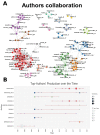The Impact of Constrictotermes cyphergaster (Termitidae: Nasutitermitinae) Termites on Semiarid Ecosystems in Brazil: A Review of Current Research
- PMID: 36005329
- PMCID: PMC9409220
- DOI: 10.3390/insects13080704
The Impact of Constrictotermes cyphergaster (Termitidae: Nasutitermitinae) Termites on Semiarid Ecosystems in Brazil: A Review of Current Research
Abstract
Termites have global distributions and play important roles in most ecosystems, often with high nest densities and interesting associations with other organisms. Constrictotermes cyphergaster, is a termite endemic to South America, widely distributed and very conspicuous, and has therefore been considered a good model for filling in gaps in general termite ecology and their relationships with other organisms (e.g., termitophily). A systematic review (content and bibliometric analyses) was used to gather all published scientific knowledge related to C. cyphergaster as well as to observe trends, verify gaps, and direct new perspectives for future studies of this species. We identified 54 studies, of which more than 50% were published in the last five years (28 articles). The majority of the articles investigated the relationships between C. cyphergaster and macroorganisms (44.4%), followed by specific aspects of its biology (25.9%). The collaboration network revealed that links between researchers are still limited and modular, but trending topics have changed over time. Additionally, there are differences in the aims of the studies being carried out in the Caatinga and Cerrado domains, with some information focusing only on one of those environments. Our results show that some gaps in the biology and ecology of C. cyphergaster remain to be explored, although collaborative efforts between researchers open opportunities for suggesting future studies that would make relevant contributions to the general knowledge of termites.
Keywords: Blattaria; Isoptera; review; tropical forests.
Conflict of interest statement
The authors declare no conflict of interest.
Figures







Similar articles
-
Constrictotermes cyphergaster (Blattaria, Termitidae) termite nests as substrates for lichen fixation in the semiarid region of northeastern Brazil.Braz J Biol. 2020 Sep;80(3):685-687. doi: 10.1590/1519-6984.222440. Epub 2019 Oct 24. Braz J Biol. 2020. PMID: 31664314 No abstract available.
-
[Association of Constrictotermes cyphergaster Silvestri (Isoptera: Termitidae) with trees in the Brazilian Cerrado].Neotrop Entomol. 2006 Jan-Feb;35(1):49-55. doi: 10.1590/s1519-566x2006000100007. Neotrop Entomol. 2006. PMID: 17352068 Portuguese.
-
Biomass and population structure of Constrictotermes cyphergaster (Silvestri) (Isoptera: termitidae) in the dry forest of caatinga, northeastern Brazil.Neotrop Entomol. 2007 Sep-Oct;36(5):693-8. doi: 10.1590/s1519-566x2007000500009. Neotrop Entomol. 2007. PMID: 18060294
-
Biology of invasive termites: a worldwide review.Annu Rev Entomol. 2013;58:455-74. doi: 10.1146/annurev-ento-120811-153554. Epub 2012 Sep 27. Annu Rev Entomol. 2013. PMID: 23020620 Review.
-
Prospects for the biological control of subterranean termites (Isoptera: rhinotermitidae), with special reference to Coptotermes formosanus.Bull Entomol Res. 2000 Feb;90(1):9-21. Bull Entomol Res. 2000. PMID: 10948359 Review.
References
-
- Clement R.A., Flores-Moreno H., Cernusak L.A., Cheesman A.W., Yatsko A.R., Allison S.D., Eggleton P., Zanne A.E. Assessing the Australian Termite Diversity Anomaly: How Habitat and Rainfall Affect Termite Assemblages. Front. Ecol. Evol. 2021;9:1–13. doi: 10.3389/fevo.2021.657444. - DOI
-
- Abe S.S., Watanabe Y., Onishi T., Kotegawa T., Wakatsuki T. Nutrient storage in termite (Macrotermes bellicosus) mounds and the implications for nutrient dynamics in a tropical savanna Ultisol. Soil Sci. Plant. Nutr. 2011;57:786–795. doi: 10.1080/00380768.2011.640922. - DOI
-
- Rückamp D., Martius C., Bragança M.A.L., Amelung W. Lignin patterns in soil and termite nests of the Brazilian Cerrado. Appl. Soil Ecol. 2011;48:45–52. doi: 10.1016/j.apsoil.2011.02.003. - DOI
-
- Rückamp D., Amelung W., Theisz N., Bandeira A.G., Martius C. Phosphorus forms in Brazilian termite nests and soils: Relevance of feeding guild and ecosystems. Geoderma. 2010;155:269–279. doi: 10.1016/j.geoderma.2009.12.010. - DOI
-
- Rückamp D., Martius C., Bornemann L., Kurzatkowski D. Geoderma Soil genesis and heterogeneity of phosphorus forms and carbon below mounds inhabited by primary and secondary termites. Geoderma. 2012;170:239–250. doi: 10.1016/j.geoderma.2011.10.004. - DOI
Publication types
Grants and funding
LinkOut - more resources
Full Text Sources

